For several years now, numerous real estate agencies and professionals in the sector have been calling me because they want to improve the images of the properties they sell. The real estate photography workshop that I have developed within my activity as a commercial photographer is aimed at real estate agents, sellers, listers, managers, and professionals in the sector with two aspects in common: One, they are not photographers, they are real estate agents. Two,
they have little time but they know they need to take good pictures.
Real estate photography has become a primary marketing tool for companies in the sector. Although years ago the phenomenon was not so popular (they used to call me “big or exclusive agencies” with very luxurious properties) in recent years we have seen an increase in demand for
photography courses due to the boom in holiday rentals and the recovery of the real estate sector with the proliferation of new agencies geared towards a client who increasingly demands more specific services.
“The phone rings more and we sell more properties since we have good photos in our agency / Carlos Ramallo, iloftmalaga.com”
In a sector where the internet and mobile devices are the gateways to all real estate, a good image of the agency and the properties it offers is vital. As my friend and client Loraine de Zara says, real estate agencies have gone from having “walking clients” to web visitors.
“If the photo doesn’t hook, they go to another agency’s website with better photos.”
Knowing for years the sector first hand and in direct contact with the agents, in the real estate photography workshop we see the main aspects that concern and interest a professional who wants to take good pictures of a property:
- He wants to know the team you have in your hands and its possibilities. “Make the most of my camera.”
- It often faces complicated lighting situations (I call it “the immobile backlight”). “How do I get the house and the view right?”
- It doesn’t know the optimal f-stop according to lens and body to have focus control in the scenes.
- Doubts about the type of camera “setting” program. “Manual, automatic, semi-automatic, what do I use?”
- You don’t know how a flash works and its operating modes: manual flash vs TTL flash.
- Treats all lighting situations equally. Learn how to compensate for exposure.
The photographs you see in this post have been taken by real estate agents during the course in a well-known and prestigious urbanization in Marbella. They have followed some tips and “tricks” that work in real estate photography:
- To know and “understand” the property we are going to photograph. See it before you take the camera out.
- Always carry a small tripod. It will allow us to have long exposures and to be able to capture all the diversity of lights that can be given in the same space.
- Photographing at medium height. Personally I like to see what a person who is comfortably sitting on the property would see.
- Be practical. You usually have little time unless you are a professional photographer hired to spend time at the property and do a story.
- Pay attention to details before you photograph. Always inform the owner of the house that we are going to take photos so that it is as tidy and aesthetic as possible.
Normally real estate agents do not process the photographs in photoshop so they ask me to make the photoshoot as aesthetic as possible.
In the next post we will go deeper into how to get the best results in space photography. We will look at aspects such as bracketing, long exposure, zone metering, and manual flash compensation to provide the missing light in a very pronounced backlight. We will also see photoshop techniques accessible to a non-professional photographer to obtain high-performance images. If you enjoyed this post don’t hesitate to leave me a comment or contact me, I’m already working on the next one.
TAGS: Business, Cameras, Photography, Real Estate, Fashion, Professional, Advertising
Juanjo Sobrino.
